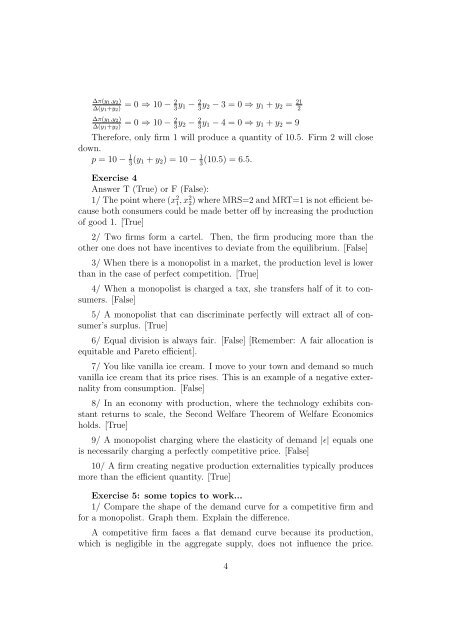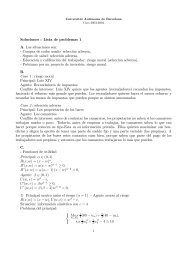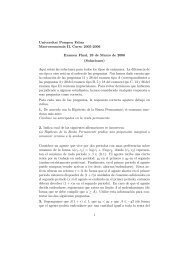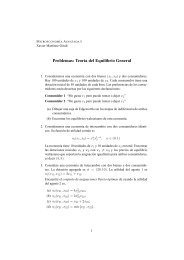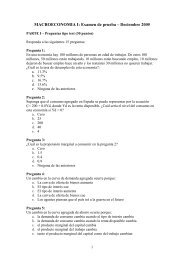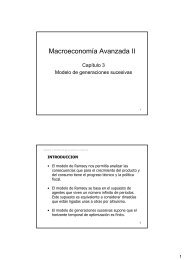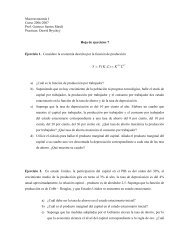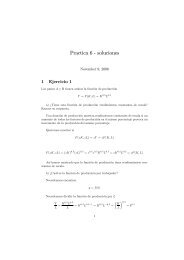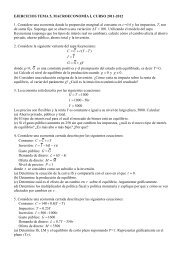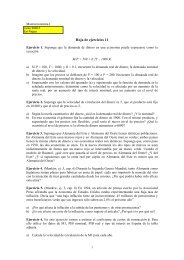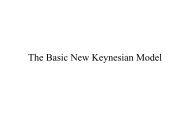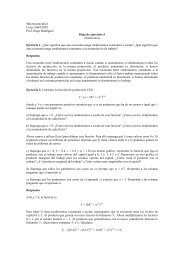Exercise 1 A monopolist has an inverse demand curve given ... - IDEA
Exercise 1 A monopolist has an inverse demand curve given ... - IDEA
Exercise 1 A monopolist has an inverse demand curve given ... - IDEA
You also want an ePaper? Increase the reach of your titles
YUMPU automatically turns print PDFs into web optimized ePapers that Google loves.
∆π(y 1 ,y 2 )<br />
∆(y 1 +y 2 ) = 0 ⇒ 10 − 2 3 y 1 − 2 3 y 2 − 3 = 0 ⇒ y 1 + y 2 = 21 2<br />
∆π(y 1 ,y 2 )<br />
= 0 ⇒ 10 − 2y ∆(y 1 +y 2 ) 3 2 − 2y 3 1 − 4 = 0 ⇒ y 1 + y 2 = 9<br />
Therefore, only firm 1 will produce a qu<strong>an</strong>tity of 10.5. Firm 2 will close<br />
down.<br />
p = 10 − 1(y 3 1 + y 2 ) = 10 − 1 (10.5) = 6.5.<br />
3<br />
<strong>Exercise</strong> 4<br />
Answer T (True) or F (False):<br />
1/ The point where (x 2 1, x 2 2) where MRS=2 <strong>an</strong>d MRT=1 is not efficient because<br />
both consumers could be made better off by increasing the production<br />
of good 1. [True]<br />
2/ Two firms form a cartel. Then, the firm producing more th<strong>an</strong> the<br />
other one does not have incentives to deviate from the equilibrium. [False]<br />
3/ When there is a <strong>monopolist</strong> in a market, the production level is lower<br />
th<strong>an</strong> in the case of perfect competition. [True]<br />
4/ When a <strong>monopolist</strong> is charged a tax, she tr<strong>an</strong>sfers half of it to consumers.<br />
[False]<br />
5/ A <strong>monopolist</strong> that c<strong>an</strong> discriminate perfectly will extract all of consumer’s<br />
surplus. [True]<br />
6/ Equal division is always fair. [False] [Remember: A fair allocation is<br />
equitable <strong>an</strong>d Pareto efficient].<br />
7/ You like v<strong>an</strong>illa ice cream. I move to your town <strong>an</strong>d dem<strong>an</strong>d so much<br />
v<strong>an</strong>illa ice cream that its price rises. This is <strong>an</strong> example of a negative externality<br />
from consumption. [False]<br />
8/ In <strong>an</strong> economy with production, where the technology exhibits const<strong>an</strong>t<br />
returns to scale, the Second Welfare Theorem of Welfare Economics<br />
holds. [True]<br />
9/ A <strong>monopolist</strong> charging where the elasticity of dem<strong>an</strong>d |ɛ| equals one<br />
is necessarily charging a perfectly competitive price. [False]<br />
10/ A firm creating negative production externalities typically produces<br />
more th<strong>an</strong> the efficient qu<strong>an</strong>tity. [True]<br />
<strong>Exercise</strong> 5: some topics to work...<br />
1/ Compare the shape of the dem<strong>an</strong>d <strong>curve</strong> for a competitive firm <strong>an</strong>d<br />
for a <strong>monopolist</strong>. Graph them. Explain the difference.<br />
A competitive firm faces a flat dem<strong>an</strong>d <strong>curve</strong> because its production,<br />
which is negligible in the aggregate supply, does not influence the price.<br />
4


